Report: Teaching Reading and Related Approaches in Primary Schools
VerifiedAdded on 2023/01/11
|7
|1615
|38
Report
AI Summary
This report examines the concept of teaching reading in primary schools, exploring various interactive methods and approaches. It delves into specific strategies like Fishy Phonics and reading text to the class, comparing their similarities and differences in enhancing children's reading speed and vocabulary. The report also outlines major learning theories such as behaviorism, cognitivism, constructivism, and transactionalism, providing a justification for their relevance in primary school reading instruction. It concludes by emphasizing the importance of interactive and fun approaches to engage children, improve their reading skills, and build their confidence, highlighting the significance of phonics in decoding unfamiliar words and enhancing overall learning outcomes. This report provides valuable insights for educators on effective reading instruction in primary school settings.
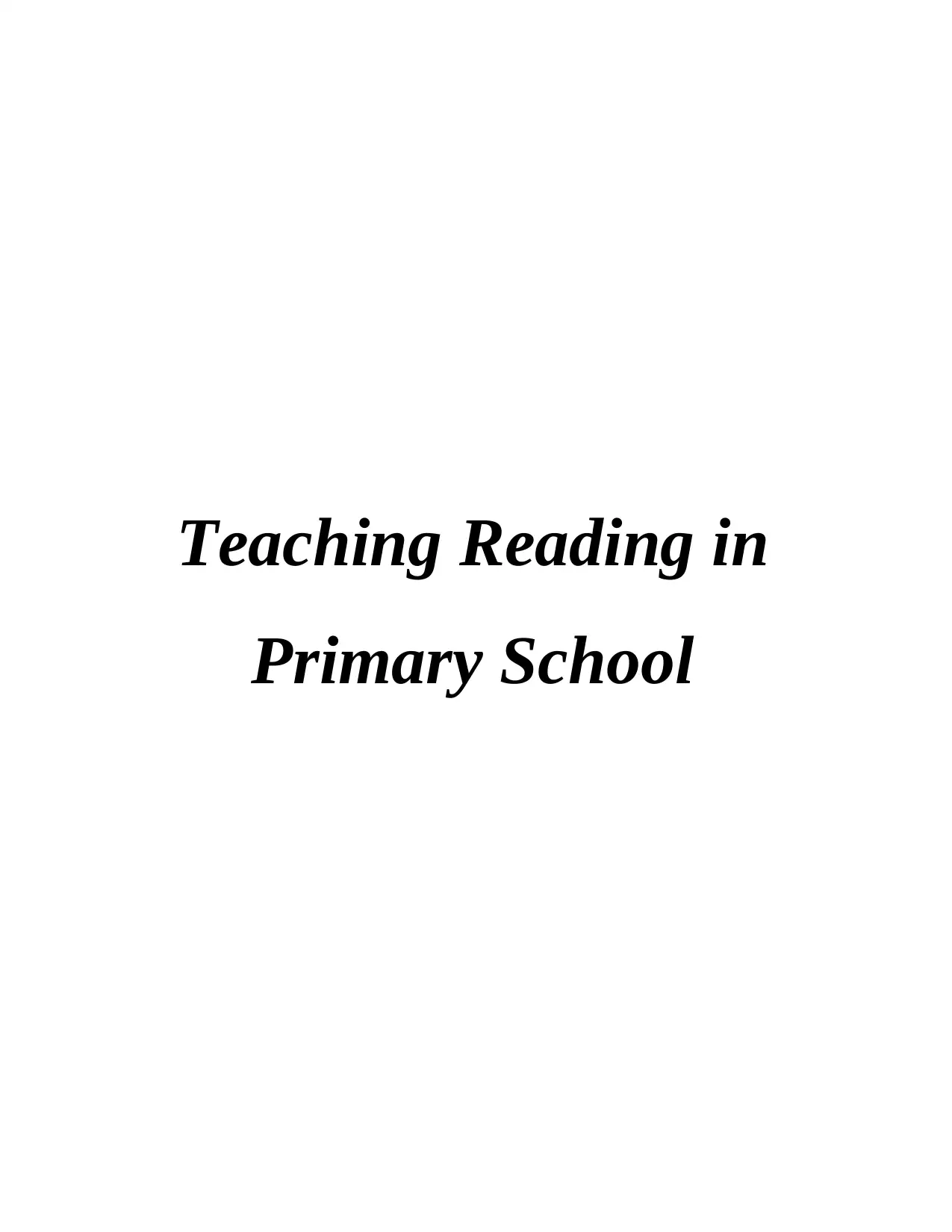
Teaching Reading in
Primary School
Primary School
Paraphrase This Document
Need a fresh take? Get an instant paraphrase of this document with our AI Paraphraser
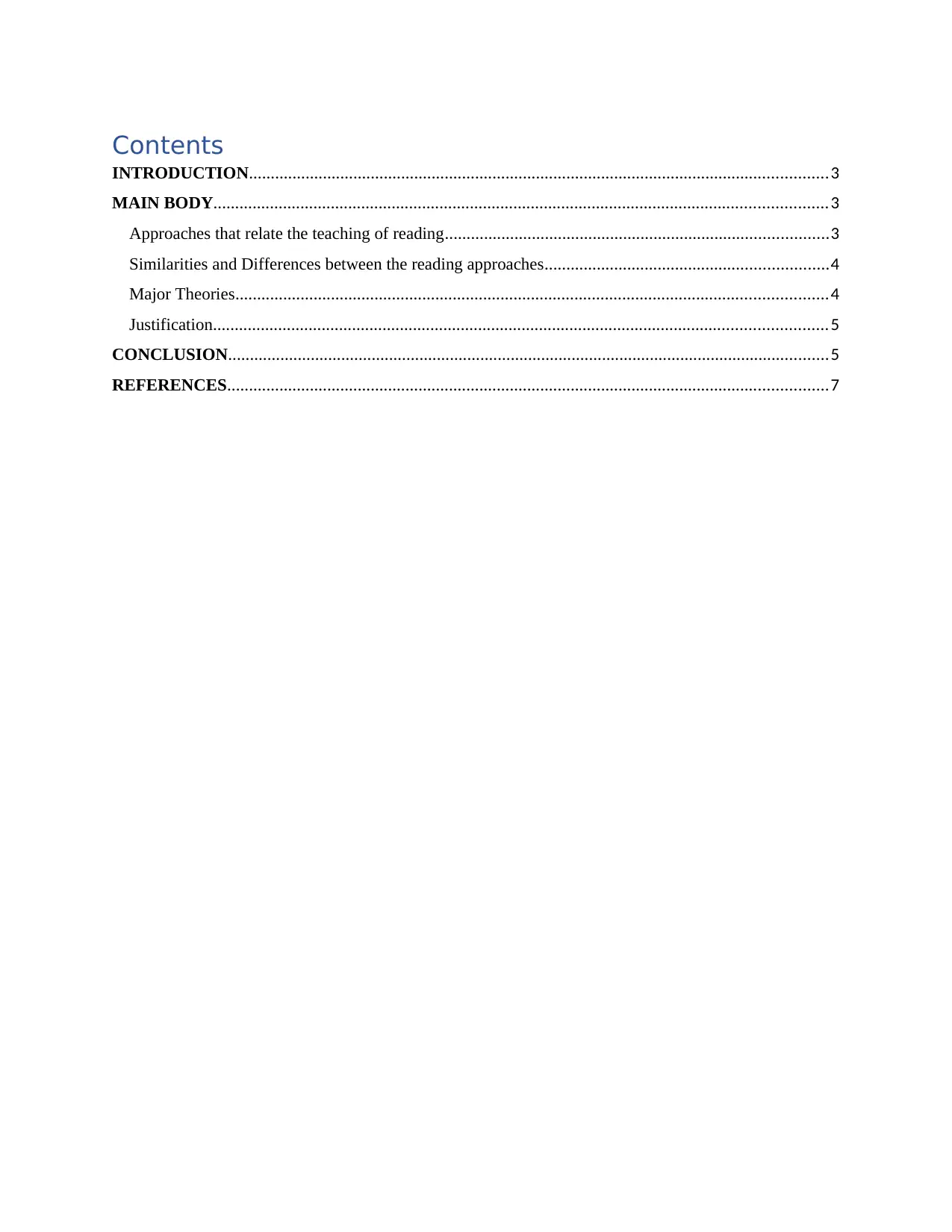
Contents
INTRODUCTION.....................................................................................................................................3
MAIN BODY.............................................................................................................................................3
Approaches that relate the teaching of reading........................................................................................3
Similarities and Differences between the reading approaches.................................................................4
Major Theories........................................................................................................................................4
Justification.............................................................................................................................................5
CONCLUSION..........................................................................................................................................5
REFERENCES..........................................................................................................................................7
INTRODUCTION.....................................................................................................................................3
MAIN BODY.............................................................................................................................................3
Approaches that relate the teaching of reading........................................................................................3
Similarities and Differences between the reading approaches.................................................................4
Major Theories........................................................................................................................................4
Justification.............................................................................................................................................5
CONCLUSION..........................................................................................................................................5
REFERENCES..........................................................................................................................................7
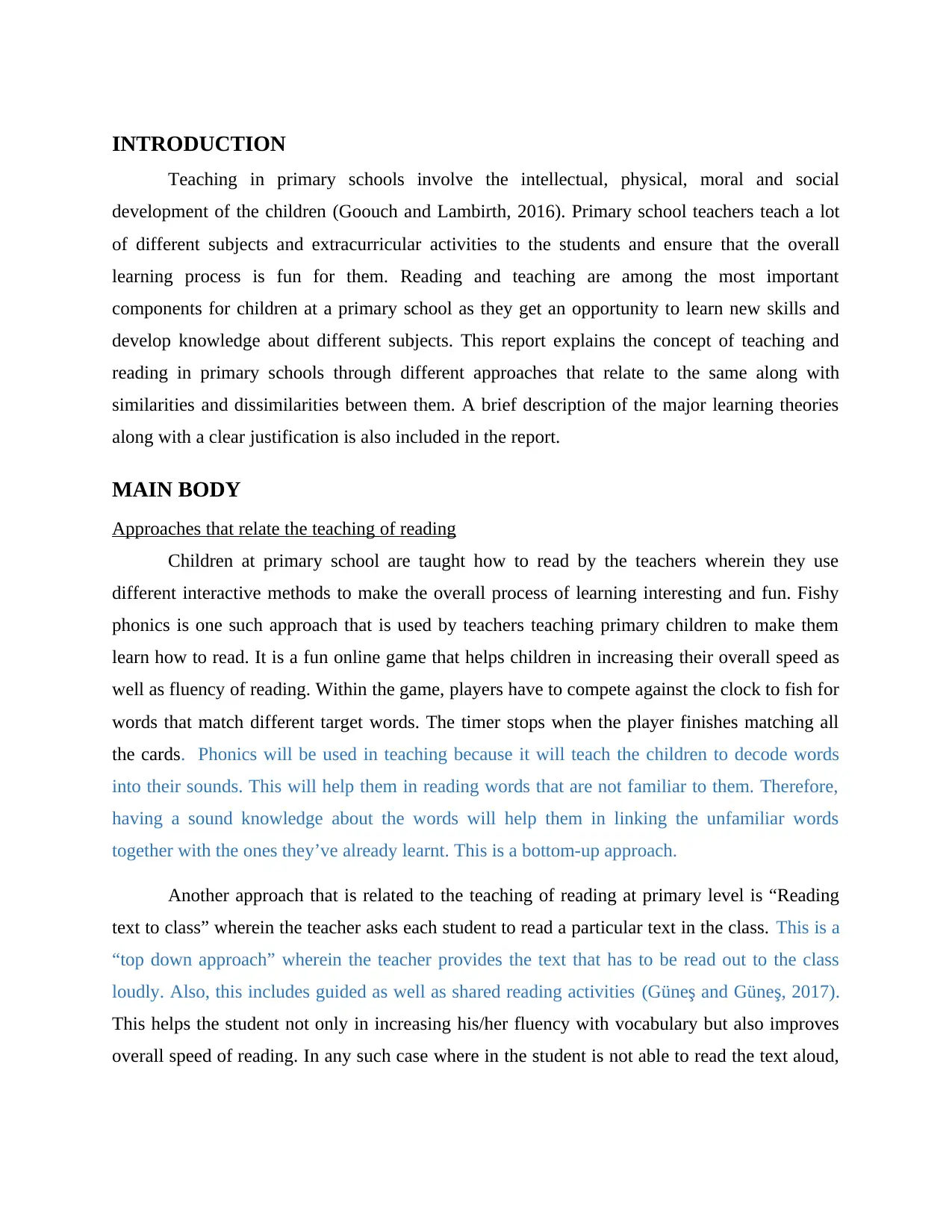
INTRODUCTION
Teaching in primary schools involve the intellectual, physical, moral and social
development of the children (Goouch and Lambirth, 2016). Primary school teachers teach a lot
of different subjects and extracurricular activities to the students and ensure that the overall
learning process is fun for them. Reading and teaching are among the most important
components for children at a primary school as they get an opportunity to learn new skills and
develop knowledge about different subjects. This report explains the concept of teaching and
reading in primary schools through different approaches that relate to the same along with
similarities and dissimilarities between them. A brief description of the major learning theories
along with a clear justification is also included in the report.
MAIN BODY
Approaches that relate the teaching of reading
Children at primary school are taught how to read by the teachers wherein they use
different interactive methods to make the overall process of learning interesting and fun. Fishy
phonics is one such approach that is used by teachers teaching primary children to make them
learn how to read. It is a fun online game that helps children in increasing their overall speed as
well as fluency of reading. Within the game, players have to compete against the clock to fish for
words that match different target words. The timer stops when the player finishes matching all
the cards. Phonics will be used in teaching because it will teach the children to decode words
into their sounds. This will help them in reading words that are not familiar to them. Therefore,
having a sound knowledge about the words will help them in linking the unfamiliar words
together with the ones they’ve already learnt. This is a bottom-up approach.
Another approach that is related to the teaching of reading at primary level is “Reading
text to class” wherein the teacher asks each student to read a particular text in the class. This is a
“top down approach” wherein the teacher provides the text that has to be read out to the class
loudly. Also, this includes guided as well as shared reading activities (Güneş and Güneş, 2017).
This helps the student not only in increasing his/her fluency with vocabulary but also improves
overall speed of reading. In any such case where in the student is not able to read the text aloud,
Teaching in primary schools involve the intellectual, physical, moral and social
development of the children (Goouch and Lambirth, 2016). Primary school teachers teach a lot
of different subjects and extracurricular activities to the students and ensure that the overall
learning process is fun for them. Reading and teaching are among the most important
components for children at a primary school as they get an opportunity to learn new skills and
develop knowledge about different subjects. This report explains the concept of teaching and
reading in primary schools through different approaches that relate to the same along with
similarities and dissimilarities between them. A brief description of the major learning theories
along with a clear justification is also included in the report.
MAIN BODY
Approaches that relate the teaching of reading
Children at primary school are taught how to read by the teachers wherein they use
different interactive methods to make the overall process of learning interesting and fun. Fishy
phonics is one such approach that is used by teachers teaching primary children to make them
learn how to read. It is a fun online game that helps children in increasing their overall speed as
well as fluency of reading. Within the game, players have to compete against the clock to fish for
words that match different target words. The timer stops when the player finishes matching all
the cards. Phonics will be used in teaching because it will teach the children to decode words
into their sounds. This will help them in reading words that are not familiar to them. Therefore,
having a sound knowledge about the words will help them in linking the unfamiliar words
together with the ones they’ve already learnt. This is a bottom-up approach.
Another approach that is related to the teaching of reading at primary level is “Reading
text to class” wherein the teacher asks each student to read a particular text in the class. This is a
“top down approach” wherein the teacher provides the text that has to be read out to the class
loudly. Also, this includes guided as well as shared reading activities (Güneş and Güneş, 2017).
This helps the student not only in increasing his/her fluency with vocabulary but also improves
overall speed of reading. In any such case where in the student is not able to read the text aloud,
⊘ This is a preview!⊘
Do you want full access?
Subscribe today to unlock all pages.

Trusted by 1+ million students worldwide
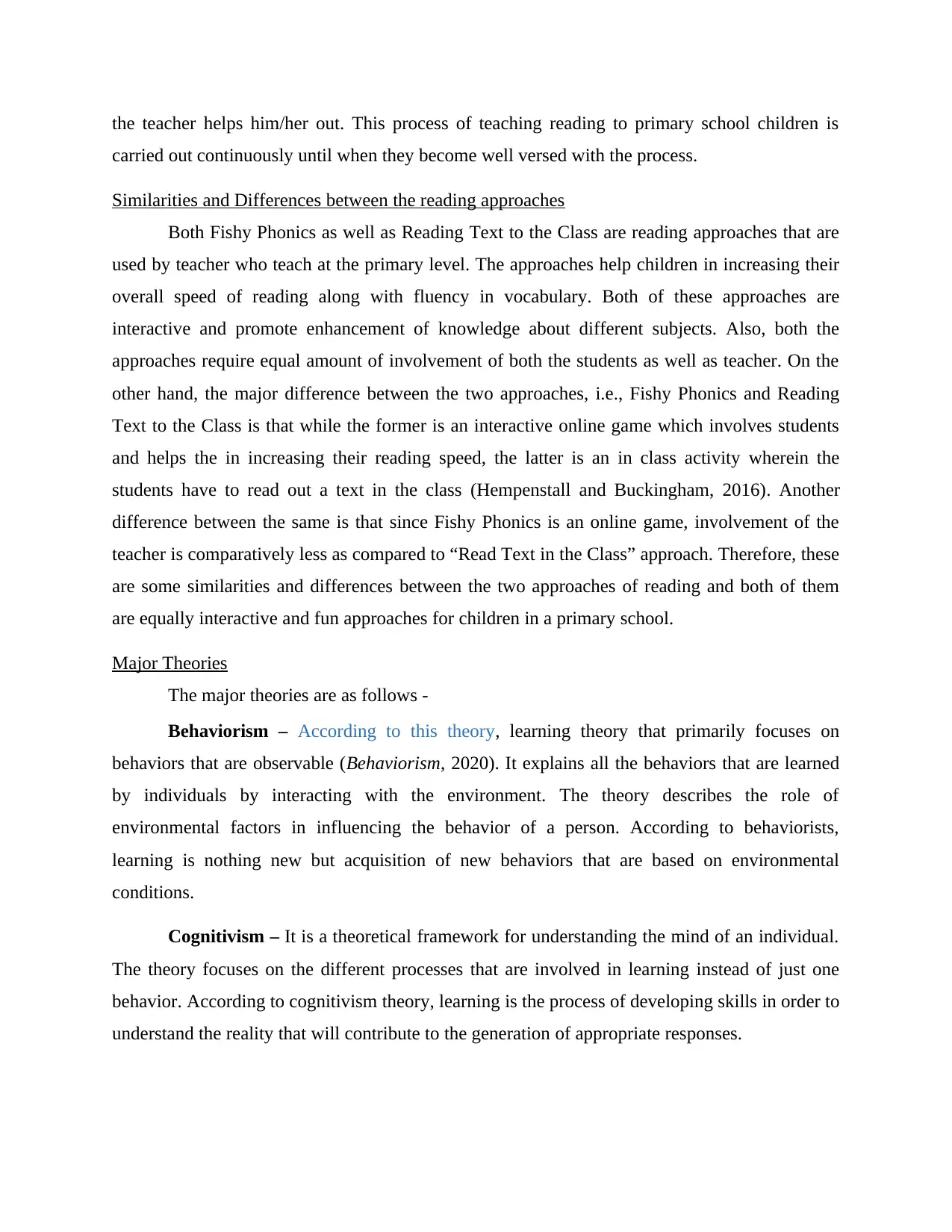
the teacher helps him/her out. This process of teaching reading to primary school children is
carried out continuously until when they become well versed with the process.
Similarities and Differences between the reading approaches
Both Fishy Phonics as well as Reading Text to the Class are reading approaches that are
used by teacher who teach at the primary level. The approaches help children in increasing their
overall speed of reading along with fluency in vocabulary. Both of these approaches are
interactive and promote enhancement of knowledge about different subjects. Also, both the
approaches require equal amount of involvement of both the students as well as teacher. On the
other hand, the major difference between the two approaches, i.e., Fishy Phonics and Reading
Text to the Class is that while the former is an interactive online game which involves students
and helps the in increasing their reading speed, the latter is an in class activity wherein the
students have to read out a text in the class (Hempenstall and Buckingham, 2016). Another
difference between the same is that since Fishy Phonics is an online game, involvement of the
teacher is comparatively less as compared to “Read Text in the Class” approach. Therefore, these
are some similarities and differences between the two approaches of reading and both of them
are equally interactive and fun approaches for children in a primary school.
Major Theories
The major theories are as follows -
Behaviorism – According to this theory, learning theory that primarily focuses on
behaviors that are observable (Behaviorism, 2020). It explains all the behaviors that are learned
by individuals by interacting with the environment. The theory describes the role of
environmental factors in influencing the behavior of a person. According to behaviorists,
learning is nothing new but acquisition of new behaviors that are based on environmental
conditions.
Cognitivism – It is a theoretical framework for understanding the mind of an individual.
The theory focuses on the different processes that are involved in learning instead of just one
behavior. According to cognitivism theory, learning is the process of developing skills in order to
understand the reality that will contribute to the generation of appropriate responses.
carried out continuously until when they become well versed with the process.
Similarities and Differences between the reading approaches
Both Fishy Phonics as well as Reading Text to the Class are reading approaches that are
used by teacher who teach at the primary level. The approaches help children in increasing their
overall speed of reading along with fluency in vocabulary. Both of these approaches are
interactive and promote enhancement of knowledge about different subjects. Also, both the
approaches require equal amount of involvement of both the students as well as teacher. On the
other hand, the major difference between the two approaches, i.e., Fishy Phonics and Reading
Text to the Class is that while the former is an interactive online game which involves students
and helps the in increasing their reading speed, the latter is an in class activity wherein the
students have to read out a text in the class (Hempenstall and Buckingham, 2016). Another
difference between the same is that since Fishy Phonics is an online game, involvement of the
teacher is comparatively less as compared to “Read Text in the Class” approach. Therefore, these
are some similarities and differences between the two approaches of reading and both of them
are equally interactive and fun approaches for children in a primary school.
Major Theories
The major theories are as follows -
Behaviorism – According to this theory, learning theory that primarily focuses on
behaviors that are observable (Behaviorism, 2020). It explains all the behaviors that are learned
by individuals by interacting with the environment. The theory describes the role of
environmental factors in influencing the behavior of a person. According to behaviorists,
learning is nothing new but acquisition of new behaviors that are based on environmental
conditions.
Cognitivism – It is a theoretical framework for understanding the mind of an individual.
The theory focuses on the different processes that are involved in learning instead of just one
behavior. According to cognitivism theory, learning is the process of developing skills in order to
understand the reality that will contribute to the generation of appropriate responses.
Paraphrase This Document
Need a fresh take? Get an instant paraphrase of this document with our AI Paraphraser
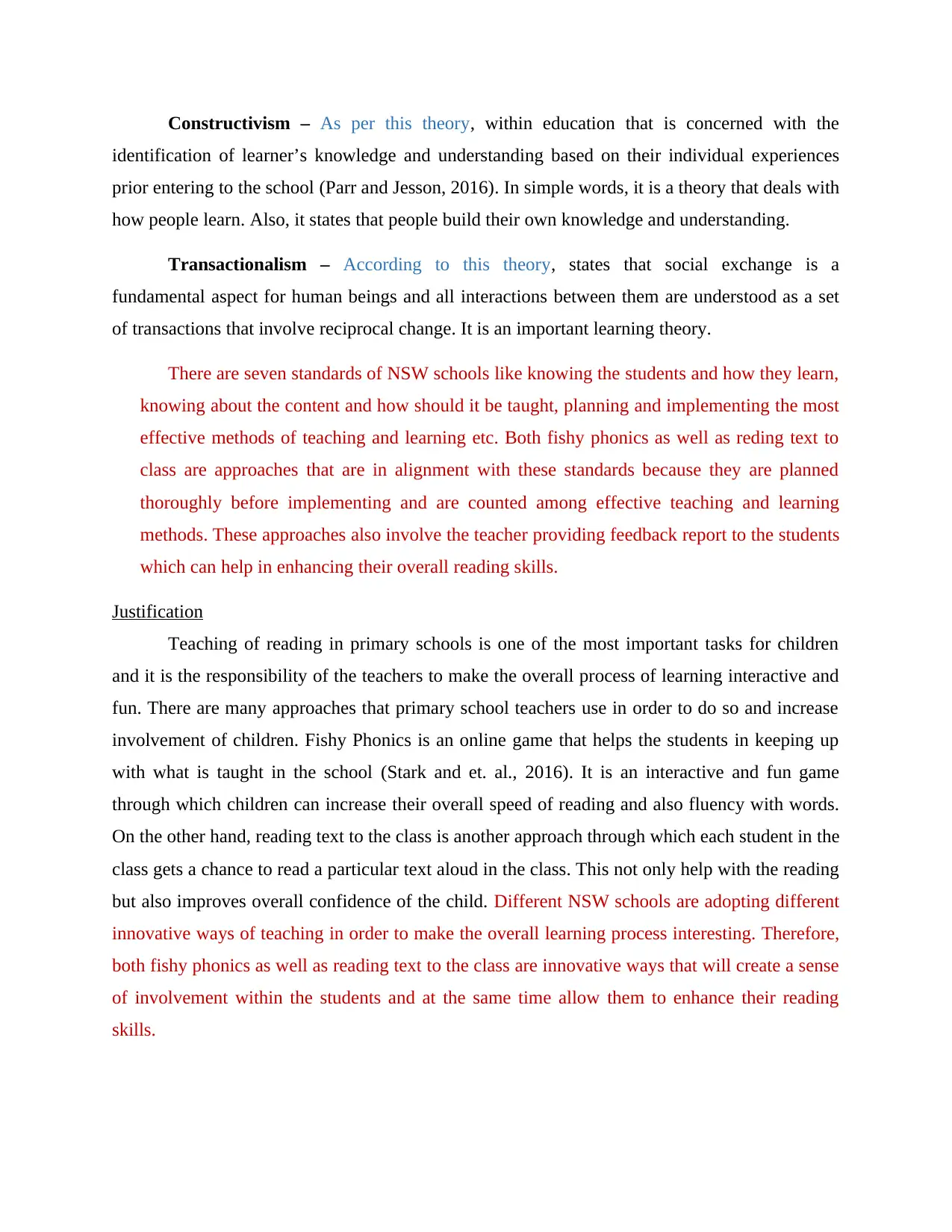
Constructivism – As per this theory, within education that is concerned with the
identification of learner’s knowledge and understanding based on their individual experiences
prior entering to the school (Parr and Jesson, 2016). In simple words, it is a theory that deals with
how people learn. Also, it states that people build their own knowledge and understanding.
Transactionalism – According to this theory, states that social exchange is a
fundamental aspect for human beings and all interactions between them are understood as a set
of transactions that involve reciprocal change. It is an important learning theory.
There are seven standards of NSW schools like knowing the students and how they learn,
knowing about the content and how should it be taught, planning and implementing the most
effective methods of teaching and learning etc. Both fishy phonics as well as reding text to
class are approaches that are in alignment with these standards because they are planned
thoroughly before implementing and are counted among effective teaching and learning
methods. These approaches also involve the teacher providing feedback report to the students
which can help in enhancing their overall reading skills.
Justification
Teaching of reading in primary schools is one of the most important tasks for children
and it is the responsibility of the teachers to make the overall process of learning interactive and
fun. There are many approaches that primary school teachers use in order to do so and increase
involvement of children. Fishy Phonics is an online game that helps the students in keeping up
with what is taught in the school (Stark and et. al., 2016). It is an interactive and fun game
through which children can increase their overall speed of reading and also fluency with words.
On the other hand, reading text to the class is another approach through which each student in the
class gets a chance to read a particular text aloud in the class. This not only help with the reading
but also improves overall confidence of the child. Different NSW schools are adopting different
innovative ways of teaching in order to make the overall learning process interesting. Therefore,
both fishy phonics as well as reading text to the class are innovative ways that will create a sense
of involvement within the students and at the same time allow them to enhance their reading
skills.
identification of learner’s knowledge and understanding based on their individual experiences
prior entering to the school (Parr and Jesson, 2016). In simple words, it is a theory that deals with
how people learn. Also, it states that people build their own knowledge and understanding.
Transactionalism – According to this theory, states that social exchange is a
fundamental aspect for human beings and all interactions between them are understood as a set
of transactions that involve reciprocal change. It is an important learning theory.
There are seven standards of NSW schools like knowing the students and how they learn,
knowing about the content and how should it be taught, planning and implementing the most
effective methods of teaching and learning etc. Both fishy phonics as well as reding text to
class are approaches that are in alignment with these standards because they are planned
thoroughly before implementing and are counted among effective teaching and learning
methods. These approaches also involve the teacher providing feedback report to the students
which can help in enhancing their overall reading skills.
Justification
Teaching of reading in primary schools is one of the most important tasks for children
and it is the responsibility of the teachers to make the overall process of learning interactive and
fun. There are many approaches that primary school teachers use in order to do so and increase
involvement of children. Fishy Phonics is an online game that helps the students in keeping up
with what is taught in the school (Stark and et. al., 2016). It is an interactive and fun game
through which children can increase their overall speed of reading and also fluency with words.
On the other hand, reading text to the class is another approach through which each student in the
class gets a chance to read a particular text aloud in the class. This not only help with the reading
but also improves overall confidence of the child. Different NSW schools are adopting different
innovative ways of teaching in order to make the overall learning process interesting. Therefore,
both fishy phonics as well as reading text to the class are innovative ways that will create a sense
of involvement within the students and at the same time allow them to enhance their reading
skills.
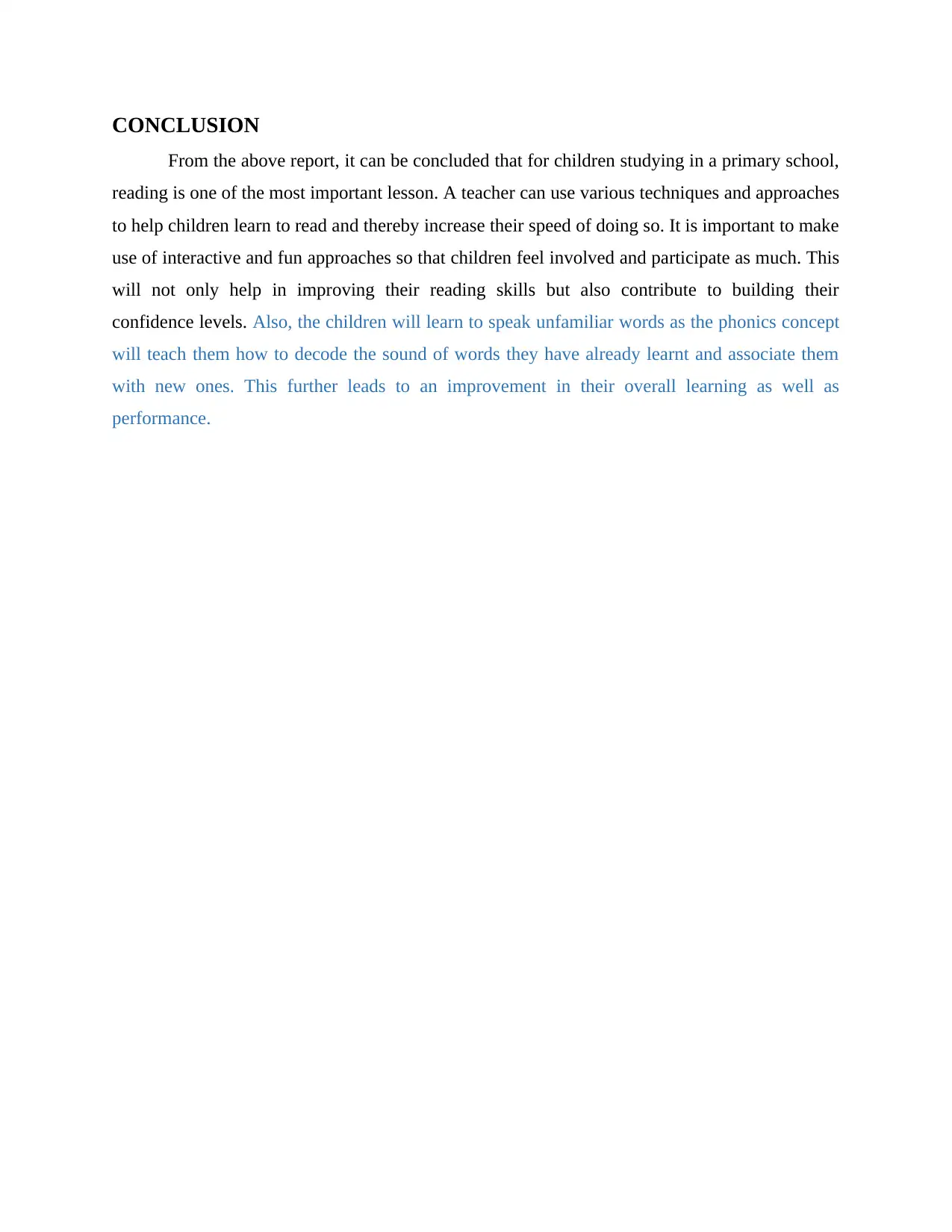
CONCLUSION
From the above report, it can be concluded that for children studying in a primary school,
reading is one of the most important lesson. A teacher can use various techniques and approaches
to help children learn to read and thereby increase their speed of doing so. It is important to make
use of interactive and fun approaches so that children feel involved and participate as much. This
will not only help in improving their reading skills but also contribute to building their
confidence levels. Also, the children will learn to speak unfamiliar words as the phonics concept
will teach them how to decode the sound of words they have already learnt and associate them
with new ones. This further leads to an improvement in their overall learning as well as
performance.
From the above report, it can be concluded that for children studying in a primary school,
reading is one of the most important lesson. A teacher can use various techniques and approaches
to help children learn to read and thereby increase their speed of doing so. It is important to make
use of interactive and fun approaches so that children feel involved and participate as much. This
will not only help in improving their reading skills but also contribute to building their
confidence levels. Also, the children will learn to speak unfamiliar words as the phonics concept
will teach them how to decode the sound of words they have already learnt and associate them
with new ones. This further leads to an improvement in their overall learning as well as
performance.
⊘ This is a preview!⊘
Do you want full access?
Subscribe today to unlock all pages.

Trusted by 1+ million students worldwide
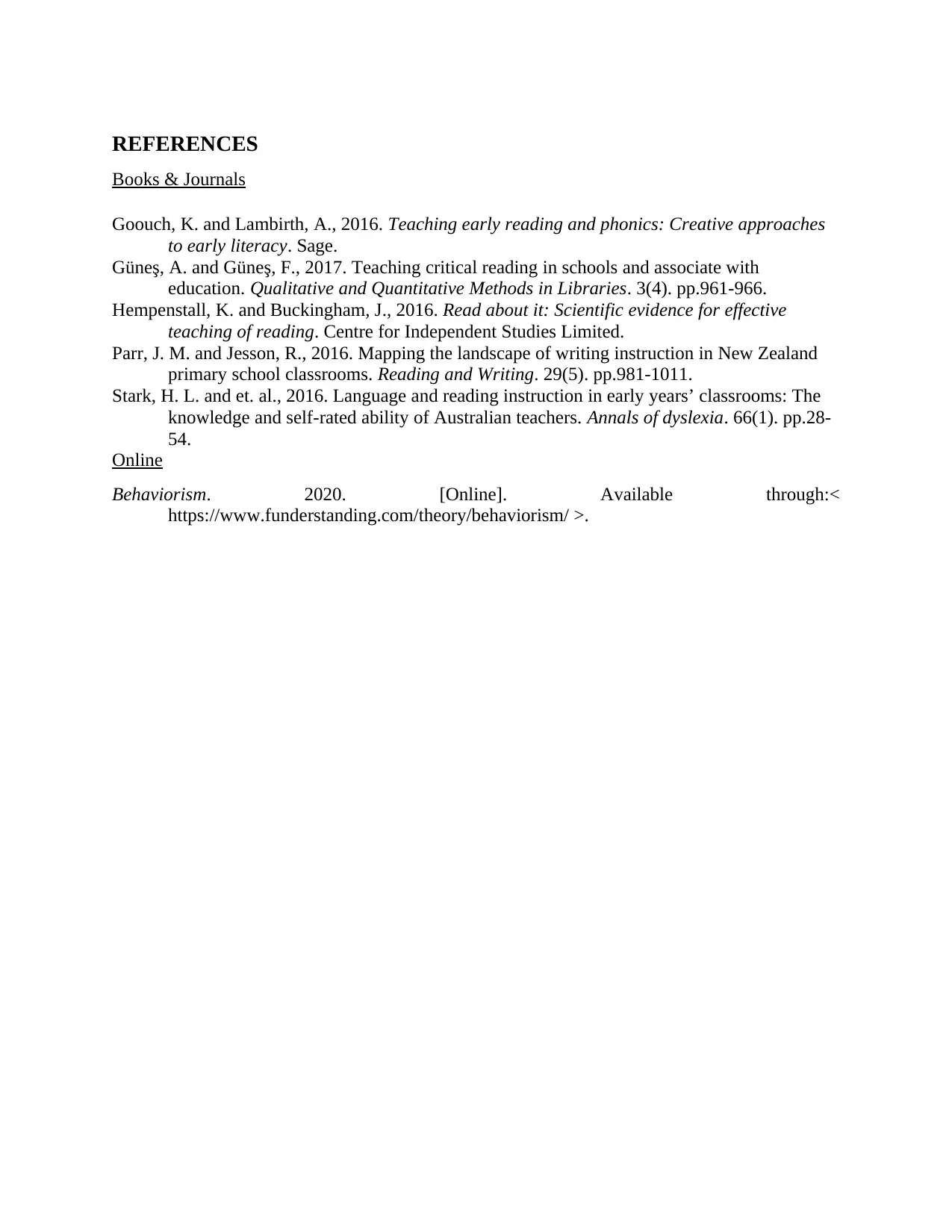
REFERENCES
Books & Journals
Goouch, K. and Lambirth, A., 2016. Teaching early reading and phonics: Creative approaches
to early literacy. Sage.
Güneş, A. and Güneş, F., 2017. Teaching critical reading in schools and associate with
education. Qualitative and Quantitative Methods in Libraries. 3(4). pp.961-966.
Hempenstall, K. and Buckingham, J., 2016. Read about it: Scientific evidence for effective
teaching of reading. Centre for Independent Studies Limited.
Parr, J. M. and Jesson, R., 2016. Mapping the landscape of writing instruction in New Zealand
primary school classrooms. Reading and Writing. 29(5). pp.981-1011.
Stark, H. L. and et. al., 2016. Language and reading instruction in early years’ classrooms: The
knowledge and self-rated ability of Australian teachers. Annals of dyslexia. 66(1). pp.28-
54.
Online
Behaviorism. 2020. [Online]. Available through:<
https://www.funderstanding.com/theory/behaviorism/ >.
Books & Journals
Goouch, K. and Lambirth, A., 2016. Teaching early reading and phonics: Creative approaches
to early literacy. Sage.
Güneş, A. and Güneş, F., 2017. Teaching critical reading in schools and associate with
education. Qualitative and Quantitative Methods in Libraries. 3(4). pp.961-966.
Hempenstall, K. and Buckingham, J., 2016. Read about it: Scientific evidence for effective
teaching of reading. Centre for Independent Studies Limited.
Parr, J. M. and Jesson, R., 2016. Mapping the landscape of writing instruction in New Zealand
primary school classrooms. Reading and Writing. 29(5). pp.981-1011.
Stark, H. L. and et. al., 2016. Language and reading instruction in early years’ classrooms: The
knowledge and self-rated ability of Australian teachers. Annals of dyslexia. 66(1). pp.28-
54.
Online
Behaviorism. 2020. [Online]. Available through:<
https://www.funderstanding.com/theory/behaviorism/ >.
1 out of 7
Related Documents
Your All-in-One AI-Powered Toolkit for Academic Success.
+13062052269
info@desklib.com
Available 24*7 on WhatsApp / Email
![[object Object]](/_next/static/media/star-bottom.7253800d.svg)
Unlock your academic potential
Copyright © 2020–2025 A2Z Services. All Rights Reserved. Developed and managed by ZUCOL.




